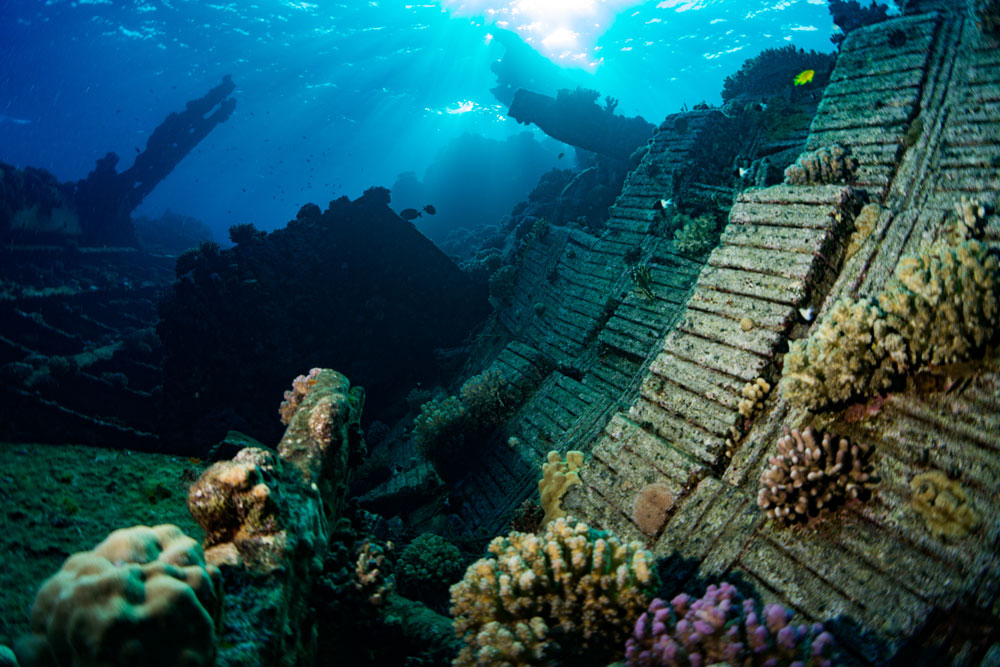
Abu Nuhas Liveaboard: Egypt Shipwreck Heaven
The wrecks of Abu Nuhas have become artificial reefs, providing habitats for a wide array of marine life. Divers can expect to see large schools of fish, moray eels, lionfish, and occasionally, turtles and dolphins. The surrounding reef areas are also bustling with underwater activity and offer a colorful contrast to the wreck dives.
About Abu Nuhas Liveaboard Diving
A liveaboard trip to Abu Nuhas in Egypt is not just a diving holiday; it's an adventure into a world where history meets the sea.
Each wreck tells a story, and exploring these underwater museums provides a unique and unforgettable diving experience. Abu Nuhas is a testament to the beauty and mystery that lies beneath the waves, waiting to be explored by those who seek to uncover the secrets of the deep.
Abu Nuhas Dive Sites
Abu Nuhas is most famous for its collection of accessible shipwrecks, each with its own story and unique dive experience:
SS Thistlegorm: While not directly in Abu Nuhas, no liveaboard trip in the area would be complete without visiting this world-renowned wreck. Sunk in 1941, it's a time capsule from World War II, laden with war supplies.
Giannis D:This Greek freighter met its fate in 1983 and now lies in two pieces. The ship’s structure is encrusted with coral and home to an abundance of marine life.
Carnatic: An English steamship that sank in 1869, the Carnatic is a beautiful fusion of man-made structure and natural reef, with its wooden beams now covered in hard and soft corals.
Chrisoula K:Known as the "Tile Wreck" for its cargo, the Chrisoula K is a popular site where divers can swim through cargo holds and explore the vibrant marine ecosystem that has taken over.
Kimon M:The "Lentil Wreck," carrying a cargo of lentils, is a deeper dive that offers a look at the ship’s massive propeller and engine room.
The wrecks of Abu Nuhas have become artificial reefs, providing habitats for a wide array of marine life. Divers can expect to see large schools of fish, moray eels, lionfish, and occasionally, turtles and dolphins. The surrounding reef areas are also bustling with underwater activity and offer a colorful contrast to the wreck dives.
Dive Conditions
The best time to visit Abu Nuhas for liveaboard diving is from March to November, with water temperatures ranging from 22°C(72°F) in the cooler months to 28°C(82°F) during the summer.Visibility is generally excellent, extending up to 30 meters(100 feet), and the currents around the wrecks vary, offering suitable conditions for both novice and experienced divers.
Opting for a liveaboard trip to Abu Nuhas provides divers with the flexibility to dive at the best times, including early mornings and late afternoons when the sites are less crowded. Liveaboards offer comfortable accommodations, delicious meals, and the expertise of dive guides who provide insights into the history and best exploration paths of each wreck.
How to Get There
Traveling to Egypt for diving at Abu Nuhas involves several steps, given that it's a remote dive site in the Red Sea. Here's a guide on how to get there for an unforgettable diving experience.
Most international travelers will first need to fly into one of Egypt's major airports. The two primary entry points are:
Cairo International Airport (CAI):As the largest airport in Egypt, Cairo offers numerous international connections. However, Cairo is quite a distance from the Red Sea coast, so you'll need a connecting flight or other transport to get closer to Abu Nuhas.
Hurghada International Airport (HRG):For many, flying into Hurghada is the more convenient option. The airport is much closer to the Red Sea dive sites, including Abu Nuhas.
After arriving in Egypt, you'll need to transfer to the city or port where your liveaboard departs. The two common points of departure for Abu Nuhas liveaboards are:
Hurghada:If you flew into Hurghada, you might be just a short drive from the marina. Liveaboards departing from Hurghada often visit several dive sites in the Northern Red Sea, including Abu Nuhas.
Sharm El-Sheikh: Alternatively, some liveaboards depart from Sharm El-Sheikh. If you flew into Cairo, you can take a domestic flight to Sharm El-Sheikh Airport (SSH). From there, it's a short journey to the marina.
Your liveaboard will navigate the Red Seatowards Abu Nuhas. Along the way, you might stop at other iconic dive sites. The journey is an integral part of the adventure, offering stunning seascapes and the chance to acclimatize to the rhythm of life at sea.
We're Here to Help 24/7






